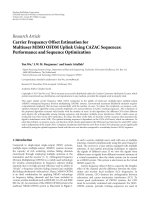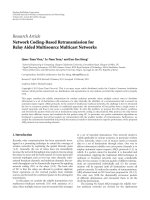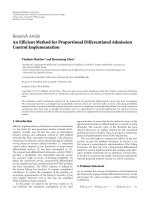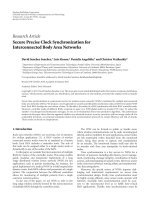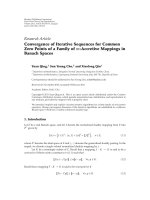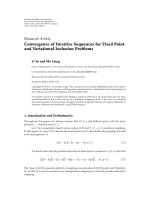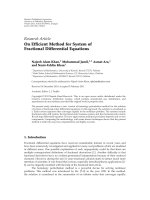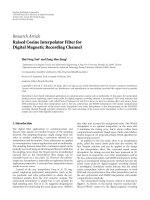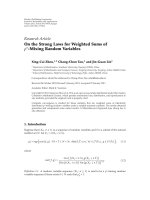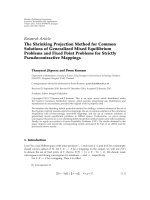Báo cáo hóa học: " Research Article Point Spread Function Estimation for a Terahertz Imaging System" pot
Bạn đang xem bản rút gọn của tài liệu. Xem và tải ngay bản đầy đủ của tài liệu tại đây (2.76 MB, 8 trang )
Hindawi Publishing Corporation
EURASIP Journal on Advances in Signal Processing
Volume 2010, Article ID 575817, 8 pages
doi:10.1155/2010/575817
Research Article
Point Spread Function Estimation for a Terahertz Imaging System
Dan C. Popescu and Andrew D. Hellicar
Wireless and Networking Technologies Laboratory, CSIRO ICT Centre, Marsfield NSW 2121, Australia
Correspondence should be addressed to Dan C. Popescu,
Received 18 June 2010; Accepted 26 August 2010
Academic Editor: Enrico Capobianco
Copyright © 2010 D. C. Popescu and A. D. Hellicar. This is an open access article distributed under the Creative Commons
Attribution License, which permits unrestricted use, distribution, and reproduction in any medium, provided the original work is
properly cited.
We present a method for estimating the point spread function of a terahertz imaging system designed to operate in reflection
mode. The method is based on imaging phantoms with known geometry, which have patterns with sharp edges at all orientations.
The point spread functions are obtained by a deconvolution technique in the Fourier domain. We validate our results by using the
estimated point spread functions to deblur several images of natural scenes and by direct comparison with a point source response.
The estimations turn out to be robust and produce consistent deblurring quality over the entire depth of the focal region of the
imaging system.
1. Introduction
Imaging systems operating in the terahertz (THz) region of
the spectrum have the potential to enable new applications
due to the unique combination of properties that occur in
this region, such as penetration through clothes, packaging
and plastics, and also the fact that THz waves are nonionising
and hence do not pose a health hazard for humans.
Application domains such as security [1], medical imaging
[2] and nondestructive testing [3]arelikelytobenefit
from developments in this area. Despite these advantages,
commercial systems in this spectral region have been slow
to emerge, due to a lack of mature THz components and
technology.
Imaging at THz frequencies poses a challenge to the res-
olution of the images that can be achieved [4], both because
of the technology’s immaturity and the long wavelengths
employed (relative to wavelengths at optical frequencies),
which are typically around or over the millimetre range. Due
to the expensive nature of terahertz imaging systems and the
likelihood of long acquisition times, there is ample scope for
employing image processing techniques, without increasing
the system cost nor image acquisition time. Knowledge of the
point spread function (PSF) of the imaging system is very
important for improving image quality.
The point spread function is the imaging system’s
response to an ideal, point-like source. In practical situations
it may not be easy to find such ideal sources, and methods
relying on direct measurement of the point spread function
from the response of a point-source approximation will
face the challenge of balancing resolution ag ainst sensitivity.
Examples of approximations for point sources include
standard stars or quasars when calibrating astronomical
instruments [ 5, 6], recording beads in microscopy [7, 8], and
pinholes into opaque materials for various optical systems
[9]. However, most practical computational methods used
for the estimation of the point spread function are indirect
and rely on some measured output of the system and possibly
some additional knowledge of the scene being imaged and
imaging system parameters. In general, these methods are
application dependent and fall into two categories: para-
metric and nonparametric methods. Parametric methods
assume that the PSF belongs to a given shape class, modelled
by a small number of parameters, such as a confusion disk or
a Gaussian, and then focus on finding a robust method for
estimating the parameters [10–13]. Nonparametric methods
[14, 15] allow for the point spread function to be of any shape
although they may still impose some mild restrictions on it,
such as not having a too large a support.
Here we propose an approach for calculating the PSF
based on the imaging of phantom objects designed to
take advantage of the imaging system characteristics. Before
explaining this approach, the system design will be discussed
along with properties of the PSF. The paper is organised
2 EURASIP Journal on Advances in Signal Processing
as follows. In Section 2 we present the architecture of our
experimental terahertz imaging system. In Section 3 we
describe the phantoms used in our experiments and the
alignment procedure. We present our PSF estimation pro-
cedure and experimental results in Section 4 and summarise
our conclusions in Section 5.
2. System Design
In the CSIRO Wireless Technologies Laboratory, we have
designed a 180 GHz coherent imaging system. The system
operates in reflection mode. A reflection mode approach
is required where the object being imaged does not allow
THz waves to penetrate through the object whereas THz
waves being scattered off the object may be detected. Practical
scenarios requiring this approach include detection of skin
lesions and cancers, explosive detection in packaging, and
corrosion detection under paint.
The configuration of the reflection mode imaging system
is shown in Figure 1(a), and the photo of the system is shown
in Figure 1(b). A target to be imaged is oriented such that
its surface is orthogonal to the direction of the THz beam
incident on the surface. The imaging system focuses the THz
beam onto the surface. Imaging proceeds by translating the
target such that the target’s surface remains at the focal point
of the system.
The focused THz beam on the target surface is created by
a quasioptical system that directs a THz beam gener ated from
a THz source. The THz source employs a smooth-walled
spline-profile horn to create a diverging Gaussian beam. T his
beam then strikes mirror M1 which collimates the beam. The
collimated beam exhibits a Gaussian amplitude distribution
and a constant phase distribution in the plane orthogonal to
the direction of beam propagation. The beam’s amplitude
cross-section does not vary between mirrors M1 and M2.
The collimated beam strikes mirror M2 and is transformed
into a Gaussian beam converging towards the focal point on
the target surface. A portion of the THz beam penetrates the
target, and the remainder is reflected across a range of angles.
The energy reflected off the target and captured by mirror
M2 is coupled through the optical system back to mirror
M1andisfocusedtowardstheTHzsource.Asiliconwafer
partial ly reflects the energy into a THz receiver.
The amplitude of the signal captured at the receiver is
used to determine the amount of energy reflected by the
target. The THz source is a continuous sine wave oscillating
at 180 GHz. Reflection at the target generates a reflected wave
which differs from the incident sine wave in both amplitude
and phase. Measurement of the phase proceeds by comparing
the phase of the signal at the THz receiver with the phase
of the THz source. The schematic diagram in Figure 1(c)
shows the electronics that achieves this comparison. A 10 dB
coupler is used to capture 10% of the transmitted signal. This
signal is mixed down to an IF frequency of approximately
1.9 GHz. The signal at the THz receiver is also mixed
down to 1.9 GHz. The two 1.9 GHz signals are then filtered
and cross-correlated to determine the phase di fference. The
described system is physically large, occupying a region of
approximately 1 m
× 1 m. However, the system is based
on electronic components which have the potential to be
reconfigured in the future into a compact configuration.
The described system has a PSF that ideally should be
Gaussian, have flat phase, and be invariant to the image
coordinates. Invariance to image coordinates follows as the
PSF does not vary as the target is translated through the fixed
beam. The depth of focus and PSF size can be calculated from
the properties of the source and receiver horns, which are
similar to those described in [16], and the focal lengths of
the mirrors M1 and M2. The resulting depth of focus is about
3.4 mm with a spot size of 2.5 mm.
3. Phantom Design
The core idea of our method is to evaluate the PSF by imaging
“phantom” objects with precisely defined geometry. The
phantom shape and alignment procedure are an extension
ofadesignwehaveproposedin[17], based on a 2-value
phase image, corresponding to π phase shifts. Here the
phantoms were designed to produce true complex images
under imaging with an ideal, delta PSF. To this end, we
manufactured two phantoms of aluminium, which has very
good reflective properties, representing the same geometric
pattern, which consists of a series of elevated concentric
disks. The radii of the disks follow a quadr atic growth law
and are 5.0, 5.3, 5.9, 6.8, 8.0, 9.5, 11.3, 13.4, 15.8, 18.5,
and 21.5 mm, respectively. There were several reasons for
choosing this particular phantom design. Firstly, we wanted
a pattern that is easy to generate automatically and to be
able to produce the ideal phantom images aligned with the
real phantom data. We wanted it to have strong edges at all
orientations, which would lead to strong components in all
Fourier domain low frequencies. This would make it suitable
for using a Wiener filter deconvolution technique, which we
detail in Section 4. We also wanted a fair degree of variability
with respect to the radial steps and, in particular, to have
at least one annular ring thinner than the expected extent
of the support of the point spread function. The elev ation
step between consecutive disks was kept constant, which
means that, for an ideal, delta-like point spread function, the
image of the phantom would be constant on every annular
ring. The elevation step was 0.4 mm for the first phantom
(which we will henceforth refer to as “Phantom 1”) and
0.2 mm for the second phantom (which we will henceforth
refer to as “Phantom 2”). The frequency of our system was
set to 180 GHz. The elevation steps on both phantoms are
not integral fractions of the wavelength, and therefore the
phase variation on consecutive disks is nonperiodic. The
phantoms were both placed within the focal zone of our
imaging system but were not perfectly aligned, in order to test
the variability of the estimated point spread function over
the focal range. Pictures of the two aluminium phantoms are
shown in Figure 2.
3.1. Phantom Image Registration. To e v aluate the point
spread function, the procedure described in the next section
requires both the actual phantom image acquired with our
EURASIP Journal on Advances in Signal Processing 3
Beam splitter
Ml
M2
Target
THz source
THz detector
(a) (b)
T
X
LNA
LO
RX
FPGA-based
digital
correlator
LNA
10 dB coupler
(c)
Figure 1: Schematic diagram (a) and real view (b) of our quasioptical system, with silicon beam splitter and two parabolic mirrors. (c)
diagram of the system electronics.
(a) (b)
Figure 2: Two aluminium phantoms, displaying a sequence of concentric disks, elevated in constant steps.
imaging system and a registered ideal phantom image of
the phantom, under a delta point spread function. In order
to generate the ideal phantom data, we firstly acquire the
complex images corresponding to the two phantoms by
scanning the aluminium phantoms pictured in Figure 2.
From these, we extra ct the phase data, on which we manually
identify several points lying on the circumference of the
outermost circle, which corresponds to the edge of the largest
disk. The coordinates of those points are fed into a procedure
of least squares circle fitting, as described in [18]. The
proposed procedure gives the best circle through the set of
points
{(x
i
, y
i
), i = 1, 2, , k} by firstly finding the vector
u
= [u
1
, u
2
, u
3
]
T
∈ R
3
as the minimiser of B
T
u − d
2
,
where d is the k-vector having component i equal to x
i
2
+ y
i
2
and B is the 3 ×k matrix having column i equal to [x
i
, y
i
,1]
T
,
for i
= 1, 2, , k. This minimiser is
u
=
BB
T
−1
Bd,
(1)
and then from (1) one finds the coordinates of the circle
center as (x
c
, y
c
) = (u
1
/2, u
2
/2) and the circle radius
as r
=
u
3
+(u
2
1
+ u
2
2
)/4. Our experiments show that
identifying around 15 pairs of points on the outermost
circle on the phantom was sufficient to get both the circle
center and radius with subpixel accuracy (i.e., feeding more
points coordinates into the algorithm did not result in any
significant variation.) In practice, about 20 pairs of point
coordinates have been used to generate the ideal phase image
data shown in Figure 3. The other inner circles are then
easy to generate automatically form the known dimensions
of the phantom. The phase value on the out most flat area,
outside the largest ring, is set to be equal to the dominant
value of corresponding area in the acquired phase image,
4 EURASIP Journal on Advances in Signal Processing
(a)
(b)
Figure 3: Left to right, in radians: phase of acquired complex phantom image, phase image generated using the circle fitting data and
knowledge of phantom geometry, and difference image. (a) corresponds to Phantom 1 and (b) to Phantom 2.
and the other phase values, constant on each ring, are
easily computed from the elevation step and the value
of the wavelength. Specifically, for every ring elevated by
an additional d mm, the phase value decreases by 4πd/λ
(because the distance d is travelled twice in reflection mode).
In our case, at 180 GHz, the wavelength λ
= 1.667 mm. The
implicit assumption is that the phantom plane is perfectly
perpendicular to the incident THz wave. The amplitude
value on the ideal phantom data is set constant and equal
to the dominant value on the area outside first ring, in the
amplitude image of the measured data. Figure 3 displays the
phantom phase images corresponding to the two phantoms,
in the context of the imaging setup described in detail in
Section 4, the ideal phantom images obtained using the data
fitting procedure outlined in this section, and the difference
images. Both sets of data are well aligned, with the main
discrepancies occurring around the thin inner annular ring
having a radius below the wavelength. However, the phase
image of Phantom 2 exhibits slightly poorer alignment to its
generated ideal phase data, compared to the same data from
Phantom 1. This is due to the fact that, in the experimental
setup, the alignment of the plane of Phantom 2 has had
a tiny deviation from a 90
◦
angle to the incident THz
beam.
4. Point Sprea d Function Estimation
If an image i(x, y) is captured with an imaging system having
point spread function p(x, y) in the presence of independent
additive noise n(x, y), then the resulting observed image
c(x, y) satisfies the equation
c
x, y
=
i
x, y
◦
p
x, y
+ n
x, y
,
(2)
where
◦ denotes convolution. Because of the commutativity
of the convolution operation, the roles of i(x, y)andp(x, y)
are dual to each other, which means that c and p can be used
to estimate i (deblurring) or c and i can b e used to estimate
p (point spread function estimation). In the absence of any
noise (n
= 0), one could find either i in terms of c and
p or p in terms of c and i from (2). The straightforward
way is to take the Fourier transform on both sides, which
maps convolution into multiplication, and then find the
Fourier transform of the unknown (either i or p) by a simple
pointwise division. However, in most practical situations, the
assumption of negl igible noise is unrealistic, and the direct
approach suggested above would lead to strong amplification
of high frequency noise. A Wiener filter approach can be used
to counter the effects of noise [19]. The point spread function
can be estimated from the equation
P
(
u, v
)
= C
(
u, v
)
I
∗
(
u, v
)
|I
(
u, v
)
|
2
+ S
n
(
u, v
)
/S
i
(
u, v
)
= C
(
u, v
)
I
∗
(
u, v
)
|I
(
u, v
)
|
2
+1/SNR
(
u, v
)
,
(3)
where C, P,andI denote the Fourier transforms of c, p,and
i and S
i
and S
n
denote the power spectra of the i and n.In
most practical situations, the inverse of the sig nal to noise
ratio is difficult to measure or estimate accurately and is
EURASIP Journal on Advances in Signal Processing 5
Figure 4: Imaging scene at 180 GHz.
often approximated by a constant s, leading to the simplified
version of the Wiener deconvolution:
P
(
u, v
)
= C
(
u, v
)
I
∗
(
u, v
)
|I
(
u, v
)
|
2
+ s
.
(4)
This approximation is particularly appropriate in the case
of white Gaussian noise and a flat signal spectrum. In the
case of reflections from a flat metal phantom, the spectrum
is flat by design. Measurements of signal reflectance with no
target have indeed confirmed that the noise in our system
closely resembles white Gaussian noise [17]. Therefore, the
simplified Wiener filter model of (4) is very suitable for our
PSF estimation.
4.1. Experimental Setup. The scene pictured in Figure 4 was
imaged with our system at 180 GHz. The scene consists of the
two phantoms previously described, a 50 cents dodecagonal
coin, and a metal keyring in the shape of a kangaroo fixed on
a Styroflex substrate. The base planes for the two phantoms
are closely aligned; however, the base plane of Phantom 2 is
about 0.5 mm in front of that of Phantom 1, while the coin
and the keyring are about 1 to 2 mm above this plane. The
entire scene fits well within the focal range of the imaging
system, which is estimated to be about 3.4 mm. A tiny metal
ball with diameter of about 2 mm has also been added to the
scene and is located slightly above and to the right of the coin.
The idea was to let this ball approximate a “point source”
and use its response for a direct estimation of the PSF shape.
The imaging data corresponding to the two phantoms were
cropped out of the image, and the algorithm described in
Section 3.1 has been applied to produce the ideal phantom
data. Subsequently, the simplified version of the Wiener filter
deconvolution of (4) has been applied to the measured and
ideal phantom images, to produce a PSF estimation. The
value of the parameter s was estimated from the measured
value of our signal and the estimated power of the noise data
to be in the range of 10
6
to 10
7
. The amplitude and phase of
the estimated point spread functions for the two phantoms
are shown in Figure 5.
We remark that the phase of the point spread function
is almost flat over the high intensity region of the PSF signal,
which is in accordance with the phase var iation of a Gaussian
beam in its focal region. This is an expected result, since our
source and receiver horns were designed to produce Gaussian
beams.
4.2. Validation. As a validation test, we use both estimated
point spread functions, obtained on the basis of two
phantom data, and the direct estimation of the point spread
function from the pinball response to deblur the natural
scene pictured i n Figure 4, consisting of the keyring and
the coin. We apply a Wiener deconvolution with s
= 0.03.
The amplitude data of the deblurred images, using the three
estimations of the point spread function, are shown in
Figure 6, and the corresponding phase images are shown in
Figure 7.
The effects of the deblurring are most noticeable on the
amplitude images of Figure 6. We remark the poor quality
of the deblurring obtained using the PSF estimated directly
from the pinball response. Admittedly, a ball with diameter
around 2 mm is not a close match to an ideal point source,
but it is, in practical terms, as close as we could get to it;
attemps to use metal balls of smaller sizes in our experiments
have resulted in response signals too weak for any reliable
estimation of their shape. By contrast, both deblurred images
using the PSFs estimated from phantom data show similar
and remarkable detail improvement. On the coin image,
the edges are sharper. Details in the area of the mouth
and nose are enhanced and some texture areas of the hair
become more prominent. The letters on the coin remain
indistinguishable, which is to be expected, because their fine
features have sizes smaller than the wavelength. However,
the overall letters’ blocks are still more visible on the two
deblurred images. A tiny horizontal image misalignment,
due to a mechanical lag of the translation table, also becomes
visible in the deblurred images, especially across the upper
half of the coin. The features on the kangaroo key ring are
enhanced, particularly around the head and the paws areas,
where the edges become b etter separated. The two PSFs
estimated from the two phantom images are not identical,
which is to be expected, given the fact that they are estimated
at slightly different depths. In spite of this, the deblurring
results on Figure 6(c) are remarkably similar. The patterns in
the phase images, shown in Figure 7(b), are more consistent
with depth geometry suggested by the optical image in
Figure 7(a). By contrast, the phase image at the right of
Figure 7(a) (corresponding to deblurring with the pinball
PSF) is again the most inconsistent with the same depth
geometry pattern.
5. Conclusions
We have presented a procedure for estimating the complex-
valued point spread function of a terahertz imaging system
which operates in reflection mode. A metal phantom with
known geometry is placed at the focal region of the system
and imaged. From this acquired phantom image and a
computed version of the ideal phantom image, registered to
the acquired image, the point spread function is estimated
6 EURASIP Journal on Advances in Signal Processing
(a)
(b)
Figure 5: Amplitude images (a) and phase images (b) of complex point spread functions. From left to right: from direct pinball response
measurement, from image data of Phantom 1, and from image data of Phantom 2.
(a)
(b)
(c)
Figure 6: (a) Optical image of kangaroo and coin scene. (b) Amplitude image of original scan at 180 GHz (left) and amplitude of deblurred
image using PSF estimated from pinball response (right). (c) Amplitude of deblurred images using the PSFs obtained by the technique
described in this section, from the image data of Phantom 1 (left) and Phantom 2 (right).
EURASIP Journal on Advances in Signal Processing 7
(a)
(b)
Figure 7: Phase images corresponding to the amplitude images in the last two rows of Figure 6.
using a Wiener filter technique. The quality of the estimated
point spread function is tested by using it to deconvolve
images of a scene containing manufactured objects with good
reflective properties. The improvement in detail areas of the
scene validates the point spread function estimation obtained
using our technique. Our methodology was applied in a
context where there was no practical alternative for esti-
mating the PSF using direct measurement of a point source
response. The only physical approximations of point sources
for which we could obtain reasonably strong response signals
were metal balls too large in size, and the PSFs estimated
from such direct measurements turned out to be of poor
quality. Estimations of the PSF at slightly different depths
around the focal plane have produced deblurring of similar
quality at all depths around the focal plane region. While
in our experiments we have only tested a THz imaging
system in reflection mode, the same technique could be
applied for a THz imaging system operating in transmission
mode; the only challenge would be the manufacturing
of a phantom from materials with precisely controlled
absorption coefficients. A study of such materials is presented
in [20].
Acknowledgment
The authors acknowledge Carl Holmesby for manufacturing
the phantoms used in our experiments.
References
[1]M.C.Kemp,P.F.Taday,B.E.Cole,J.A.Cluff,A.J.
Fitzgerald, and W. R. Tribe, “Security applications of teraher tz
technology,” in Terahertz for Military and Security Applications,
vol. 5070 of Proceedings of SPIE, pp. 44–52, April 2003.
[2]R.M.Woodward,V.P.Wallace,R.J.Pyeetal.,“Terahertz
pulse imaging of ex vivo basal cell carcinoma,” Journal of
Investigative Dermatology, vol. 120, no. 1, pp. 72–78, 2003.
[3] C. H. Chen, Ultrasonic and Advanced Methods for Nondestruc-
tive Testing and Material, World Scientific, Singapore, 2007.
[4] A. J. Fitzgerald, E. Berry, R. E. Miles, N. N. Zinovev, M. A.
Smith, and J. M. Chamberlain, “Evaluation of image quality
in terahertz pulsed imaging using test objects,” Physics in
Medicine and Biology, vol. 47, no. 21, pp. 3865–3873, 2002.
[5] M. D. Lehnert, G. K. Miley, W. B. Sparks et al., “Hubble
Space Telescope snapshot survey of 3CR quasars: the data,”
Astrophysical Journal, Supplement Series, vol. 123, no. 2, pp.
351–376, 1999.
[6] J. Teuber et al., “Rotate-and-stare: a new method for PSF
estimation,” Astronomy and Astrophysics, Supplement Series,
vol. 108, pp. 509–512, 1994.
[7]J.G.McNally,T.Karpova,J.Cooper,andJ.A.Conchello,
“Three-dimensional imaging by deconvolution microscopy,”
Methods, vol. 19, no. 3, pp. 373–385, 1999.
[8] E. Dusch, T. Dorval, N. Vincent, M. Wachsmuth, and A .
Genovesio, “Three-dimensional point spread function model
for line-scanning confocal microscope with high-aperture
objective,” Journal of Microscopy, vol. 228, no. 2, pp. 132–138,
2007.
[9] S. D. Metzler and R. Accorsi, “Resolution versus sensititvity-
effective diameter in pinhole collimation: experimental veri-
fication,” Physics in Medicine and Biology, vol. 50, no. 21, pp.
5005–5017, 2005.
[10] M. Cannon, “Blind deconvolution of spatially invariant image
blurs with phase,” IEEE Transactions on Ac oustics, Speech and
Signal Processing, vol. 24, no. 1, pp. 58–63, 1976.
[11] A. N. Rajagopalan and S. Chaudhuri, “MRF model-based
identification of shift-variant point spread function for a class
of imaging systems,” Signal Processing, vol. 76, no. 3, pp. 285–
299, 1999.
[12] M. Von Tiedemann, A. Fridberger, M. Ulfendahl, and J. Boutet
De Monvel, “Image adaptive p oint-spread function estima-
tion and deconvolution for in vivo confocal microscopy,”
Microscopy Research and Technique, vol. 69, no. 1, pp. 10–20,
2006.
[13] M. Sakano, N. Suetake, and E. Uchino, “A robust point spread
function estimation for out-of-focus blurred and noisy images
based on a distribution of gradient vectors on the polar plane,”
Optical Review, vol. 14, no. 5, pp. 297–303, 2007.
[14] T. D. Doukoglou, I. W. Hunter, and R. E. Kearney, “Nonpara-
metric two-dimensional point spread function estimation for
8 EURASIP Journal on Advances in Signal Processing
biomedical imaging,” Medical and Biological Engineering and
Computing, vol. 31, no. 3, pp. 277–283, 1993.
[15] P. Hall and P. Qiu, “Nonparametric estimation of a point-
spread function in multivariate problems,” Annals of Statistics,
vol. 35, no. 4, pp. 1512–1534, 2007.
[16] C. Granet, G. L . James, R. Bolton, and G. Moorey, “A
smooth-walled spline-profile horn as an alternative to the
corrugated horn for wide band millimeter-wave applications,”
IEEE Transactions on Antennas and Propagation, vol. 52, no. 3,
pp. 848–854, 2004.
[17] D. C. Popescu, A. Hellicar, and Y. Li, “Phantom-based point
spread function estimation for terahertz imaging system,” in
Proceedings of the 11th International Conference on Advanced
Concepts for Intelligent Vision Systems (ACIVS ’09), vol. 5807,
pp. 629–639, Bordeaux, France, October 2009.
[18] I. D. Coope, “Circle fitting by linear and nonlinear least
squares,” Journal of Optimization Theory and Applications, vol.
76, no. 2, pp. 381–388, 1993.
[19] R. C. Gonzales and R. E. Woods, Digital Image Processing,
Prentice-Hall, Englewood Cliffs, NJ, USA, 2002.
[20] G. C. Walker, E. Berry, S. W. Smye, and D. S. Brettle,
“Materials for phantoms for terahertz pulsed imaging,” Physics
in Medicine and Biology, vol. 49, no. 21, pp. 363–369, 2004.
